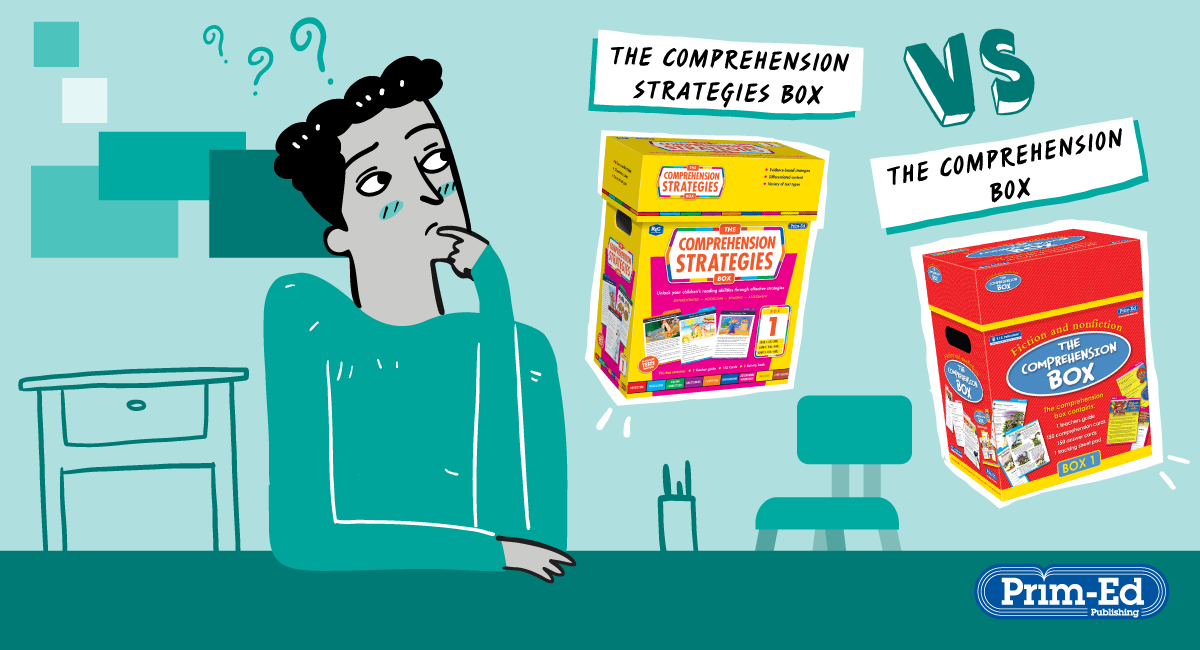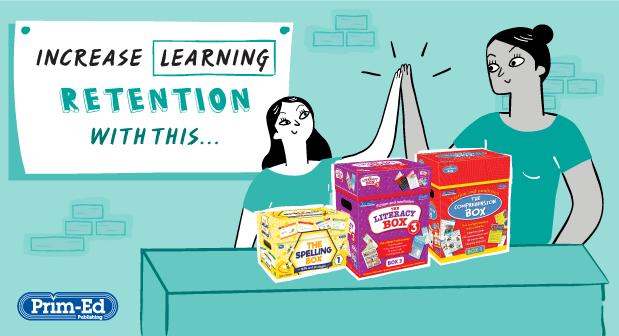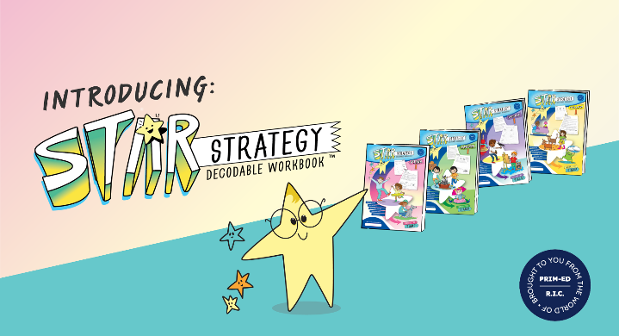- Tuesday 03 October 2023
Choosing the right option for your classroom
Are you looking to teach your learners the nine core comprehension strategies? Need to build their comprehension skills through regular practice? Look no further! We're about to introduce you to a dynamic duo: The Comprehension Strategies Box and The Comprehension Box.
These two best-selling resources are designed to give your learners everything they need in order to become confident in the area of comprehension. But what sets The Comprehension Strategies Box and The Comprehension Box apart, and how can they benefit your classroom? That's precisely what we're going to uncover.
The Comprehension Box
The Comprehension Box focuses on developing explicit comprehension strategies through the use of carefully selected reading material and activities with the central aim of creating competent, strategic readers.
There are three boxes which correspond to the three core age groups of primary school children. Each box has 150 cards, each containing a reading text. The cards are colour-coded into 15 sections that are grouped according to reading difficulty. It is envisaged that the learner will work progressively through each card in a coloured section. The coloured divisions enable educators to easily differentiate the curriculum, allowing them to provide suitably challenging material to learners at different reading levels.
The cards provide high-interest reading material that balances fiction and non-fiction texts, incorporating a variety of reading genres. The fiction genres featured throughout include science fiction, fable, poetry, and folktale, while the non-fiction genres include reports, expositions, letters, and biographies.
The topics presented on each card are also closely integrated with other curricular areas such as science, geography, history, and SPHE. This provides the educator with natural opportunities for cross-curricular links. Visually attractive artwork is featured on each card, creating interest and playing an important role in facilitating comprehension of the written text.
The strategies presented and developed in The Comprehension Box include:
- sequencing
- predicting
- identifying the main idea
- summarising
- finding cause and effect
- inferring
- differentiating fact and opinion, and
- finding similarities and differences.
Carefully selected questions follow each text. These questions are based on probing the learner's understanding of what they have read, and encompass literal, inferential, evaluative, and applied questions.
The educator confers with the learner and directs them to the coloured section which best suits their ability. Each Teacher Manual recommends a suggested reading age for each colour, giving educators a useful guide for optimally matching the card colour to the learner’s ability. The learner then self-selects a card based on interest, while also recognising that the ultimate aim is to complete every card within each colour. This ensures that while the learner gets to select the sequence of the cards, they will encounter many different topics, themes, and genres, which will broaden their reading range and interests.
Each box includes a comprehensive Teacher Guide to facilitate lesson preparation and planning. In each Teacher Guide, a 'scope-and-sequence' chart helps to identify the targeted comprehension strategies that are the focus of each card. The Teacher Guide explains key teaching points for each strategy and has an accompanying pupil poster sheet which identifies the key steps to use the strategy effectively. It also provides answers to each card, so the teacher has rapid access to all answers. The Teacher Guide is designed to have everything you'll need in one place. There is no need to spend valuable planning time creating everything from scratch, as all necessary information is included.
The Comprehension Strategies Box
The Comprehension Strategies Box provides the full range of materials needed for the teaching, practising, and assessing of nine discrete research-proven comprehension strategies, catering to the needs of all pupils in a classroom.
Each box is divided into nine colour-coded sections, with each section corresponding to a specific comprehension strategy. The order of the strategies and card colours used are the same in each box for easy identification.
|
Comprehension strategy |
Colour code |
|
Predicting |
Red |
|
Visualising |
Light blue |
|
Making connections |
Green |
|
Questioning |
Purple |
|
Clarifying |
Orange |
|
Summarising |
Dark blue |
|
Determining importance |
Pink |
|
Inferring |
Yellow |
|
Synthesising |
Brown |
For each strategy, the teacher uses a ‘modelling text’ for whole-class instruction (located in the complementary Teacher Guide) to explicitly demonstrate the strategy in use. This allows the educator to explain their own thinking processes and helps learners understand the steps involved in effectively using each strategy. As part of this modelling stage, the educator explains what the strategy is, how it is used, and why it is useful. The educator uses the text as an example of an appropriate interpretation of the text.
Learners are then given a 'sharing text' to apply the steps of the strategy. They work in pairs or small groups to practise the strategy, while the educator works in a supportive role to address any obstacles the learners are facing. Each strategy is then explored, developed, and practised through six texts specifically written to help learners grasp the strategy and apply it in context. The texts are graded using Lexile® levels to ensure that the reading complexity is carefully matched to the abilities of pupils in the class. Having six duplicate copies of each text allows the educator to group learners with similar abilities, allowing rich discussion amongst the group members as they delve deeper into the text. The texts the learners study throughout are written in a range of genres to highlight the array of writing styles available.
The texts are classified in each strategy’s colour-coded section using a Level 1, 2, or 3 symbol, with Level 1 texts written at the easiest Lexile® level for the specific year group and Level 3 texts pitched at the highest level of reading. Depending on the reading level of the learners in a given class, the educator arranges the learners into three groups (which will use a card from Level 1, 2, or 3 respectively). Each group’s member is given one of a number of duplicate copies of the text and the educator then gives each group a photocopiable activity sheet taken from the Activity Book, so the learners can practise the strategy. The educator can even choose to work directly with a specific group each day, knowing that the other two ‘independent groups’ can engage with their text and their activity sheets in a focused way. Further practice for the strategy can be given, as there is an ‘A’ and ‘B’ text for each group. To facilitate assessment and monitoring of each learner’s progress, a separate assessment text is also available in the Teacher Guide to assess how well the strategy has been acquired by each learner.
Which is the right option for your classroom?
Both The Comprehension Box and The Comprehension Strategies Box deal with comprehension and have colour-coded sections, so which is the right option for your classroom?
The answer really depends on what you want to focus on. The following points might help with that decision:
- The Comprehension Box is focused on the practice of comprehension, not the teaching of comprehension strategies. Each text in The Comprehension Box deals with a mixture of different comprehension strategies, so the assumption is that pupils have already been taught these by the teacher and that these texts are for further practice.
- The precise grouping of texts in The Comprehension Strategies Box uses Lexile® levels to ensure progression and consistency amongst boxes and texts. On the other hand, The Comprehension Box has texts that are banded and grouped into colour-coded sections that are more generally incremental in difficulty level.
- The Comprehension Strategies Box has texts at three different levels of reading difficulty – this is a huge benefit to teachers who want to assign texts to match their pupils’ abilities. These texts also allow teachers to use the box in the way that their classrooms are organised during reading and comprehension instruction. Teachers who wish to select a specific comprehension strategy to work on at a given time will require texts to develop understanding of that strategy – The Comprehension Strategies Box provides that resource material to the educator.
- The Comprehension Strategies Box is a teaching resource – it is designed to be used by the educator to teach comprehension strategies to their learners, by modelling, discussion, guided practice, and independent practice. The modelling and sharing texts in the Teacher Guide are invaluable for whole-class teaching of the strategy, while the three levels of texts are superb for reinforcement, practice, and more detailed group work.
- The Comprehension Box is focused on practice only, and excellent for independent readers or early finishers.


